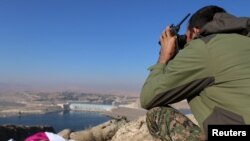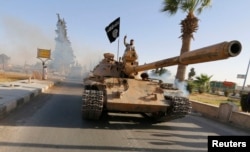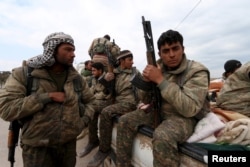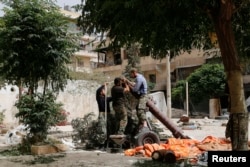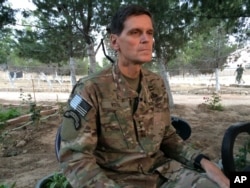When Islamic State fighters first arrived in the Syrian city of Raqqa before their leader Abu Bakr al-Baghdadi declared a caliphate the leaders of a Syrian militia called Liwa Thuwar al-Raqqa, a minor Sunni Arab armed group, adapted to the newcomers — opportunistically collaborating with them to attack rivals and even adopting the same banner as the jihadists.
Within months Liwa Thuwar al-Raqqa was pushed out of the city by IS and now it is one of a mixed bag of small Sunni Arab armed groups in the Kurdish-dominated Syrian Democratic Forces, or SDF — an alliance which the U.S. is depending on to expel IS from Raqqa, the Islamic State’s de facto Syrian capital.
U.S. officials hope the multi-sectarian make-up of the SDF will make what is in essence a formation dominated by the Kurdish People’s Protection Units, or YPG, more palatable to local Sunni Arabs.
But analysts aren’t so sure and fear that the U.S. in its eagerness to accelerate the fight against IS and to oust the jihadists from Raqqa are trying to shape a force that will encourage greater sectarianism across northern Syria.
Problems ahead
Charles Lister, an analyst at the Middle East Institute, a Washington-based think tank, worries that the U.S.-backed SDF is creating “a dangerous long-term power imbalance in northern Syria” and exacerbating the long-standing “divisions between the mainstream anti-Assad opposition and the Kurds.”
He says that despite U.S. officials continuing “to aggrandize the role of several former opposition groups and a number of small tribal, Syriac Christian and other minority community militias, our anti-IS force remains at least 75 percent YPG.”
And he worries that YPG-led victories over IS will not be sustainable in the long run.
“Syria’s mainstream opposition has the most effective track record in defeating IS on the battlefield - without any foreign air support - and its forces are those who are more likely to represent something close to durable alternative representatives to jihadist rule. It is hubris at its most extreme to focus on defeating IS now and worrying about Syria’s long-term stability later,” he says.
Mainstream Syrian rebels
The SDF has drawn the ire of mainstream Syrian rebels in the Free Syrian Army. They argue the alliance will not advance the ouster of Syrian President Bashar al-Assad and ultimately will be used by the YPG, an offshoot of Turkey’s outlawed Kurdistan Workers’ Party, or PKK, for land-grabs to unite Kurdish cantons along the border with Turkey.
Syrian rebel commanders accuse Arab militias like Liwa Thuwar al-Raqqa of being mere window dressing for the SDF, which Sunni Arabs see through. The Arab factions in the SDF are dismissed by most rebels as “the Kurdish parties.”
"The SDF is being branded more Arab than it is,” a European diplomat, speaking on the condition of anonymity, told VOA. “And it being done so not only with Raqqa in mind but with Manbij and Jarabulus,” he added. Both those towns are west of the Euphrates and Turkey has warned Washington that the YPG forces should not cross the river to seize them.
Analysts, too, warn there is little but opportunism underpinning the coalition, and that is storing up problems for the future, they say.
“The YPG's coalition, like so many in the region is not stable, but based on a few common goals,” says Joshua Landis, an American academic who specializes on the Syria conflict and publishes the Syria Comment blog.
“In this case the common goal is survival, to expel IS and to get money and arms,” he adds. The groups within the SDF “disagree on who should rule the area and basic national ambitions,” he says.
Other analysts and rebels highlight the shadiness of some in the SDF, including a notorious contraband smuggler, a sheik who wants his own tribal emirate straddling Syria and Iraq and a militia that got thrown out of the FSA for persistent criminality.
Many of the armed groups in the SDF have fallen rapidly in and out of rebel alliances, veering from aligning with more secular and nationalist-focused insurgent groups to concluding formal tie-ups with jihadists.
Liwa Thuwar al-Raqqa once swore formal allegiance to Jabhat al-Nusra, al Qaida’s affiliate in Syria. Another group, Jaysh al-Qasas, worked with IS in 2014, and according to FSA commanders has a reputation for looting.
Strange bedfellows
Most armed groups in the long-running and brutal Syria conflict have been forced by battlefield circumstances to switch alliances and to collaborate with others they are ideologically at odds with.
In defense of insurgent-held parts of Aleppo FSA brigades have made common cause at various times with al- Nusra. Survival has demanded flexibility, both for militias and individual fighters.
But the SDF's Arab fighters have been more promiscuous than most. "They are fighters who have moved from one militia to another," says Abdul Rahman, a commander with the Army of Mujahideen. "Most of them are rejects. They are not reliable," he says.
U.S. officials swing from defending the integrity of the SDF to saying that they have to work with what they have to defeat IS.
In his weekend visit to SDF training camps in northern Syria, General Joseph Votel, commander of U.S. Central Command, told reporters who accompanied him, ”I left with increased confidence in their capabilities and our ability to support them. I think that model is working and working well.”
If it does, Lister says it may only do so in the short-term. “A genuinely sustainable victory against IS necessitates a solution to the broader conflict in Syria.”




